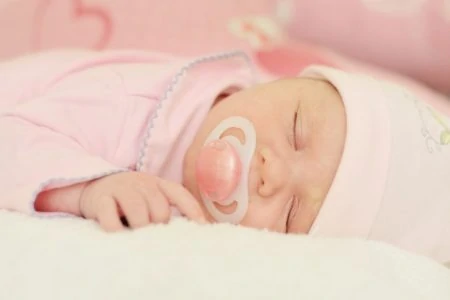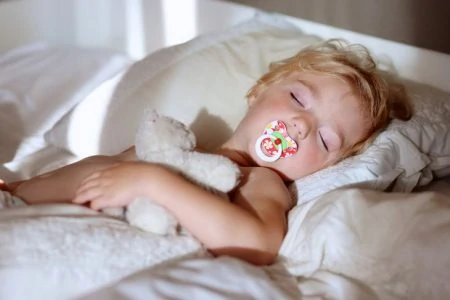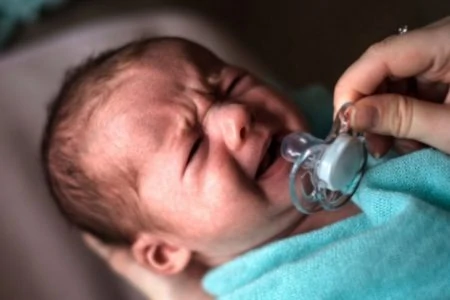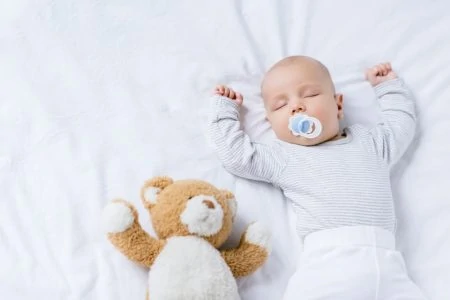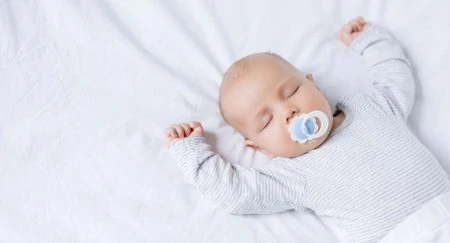Standing in the baby aisle staring at a wall of pacifiers is overwhelming. Who knew there were so many shapes, sizes, and colors for something so small? It is tough to figure out which one your baby will actually take.
We did the legwork for you. After asking fellow parents for their go-to picks and testing the top options ourselves, we narrowed it down to the best of the best. This guide breaks down safety, materials, and nipple shapes so you can find the perfect soother without buying the whole store.
- Compatible with many attachments
- Made of silicone
- Affordable
- Small and lightweight
- Includes sterilizing case
- Soft nipple with anti-slip surface
- One-piece design
- Hospital-grade silicone
- Wide base prevents choking
- Easy for baby to grab
- No latex, BPA, PVC, or phthalates
- Soft medical-grade silicone
- Unique, one-piece design
- All-natural rubber
- Simulates the feel of breast
- Can be used with pacifier clip
- Comes with a sterilizing case
- Won’t make any marks
- Easy to clean and dishwasher safe
- Safe and secure snap-lock closure
- Ergonomic design
- Fits tiny preemie mouths
- BPA free
- Helps babies learn sucking motion
Does My Baby Need a Pacifier?
Technically, no. A pacifier isn’t required for survival, but it might save your sanity. Unlike baby bottles which are for nutrition, pacifiers are purely for comfort.
If you have a baby with colic or purple crying, a pacifier is often the only thing that helps. You might notice your baby continues to suck on a bottle after it is empty, tries to comfort nurse without drinking, or sucks on their fingers. These are clear signs they have a strong sucking reflex and need a little extra soothing.
However, if your baby seems content between feeds and doesn’t hunt for things to suck on, you can skip the pacifier entirely.
Product Selection Criteria
Not all binkies are created equal. Here are the main factors to look for when shopping.
- Size and Age: Pacifiers are sized by age (usually 0, 6 months, 6, 18 months, and 18+ months). This is critical for safety. If you give an older baby a newborn pacifier, they could fit the entire shield in their mouth and choke. Always check the package.
- Construction: Look for one-piece designs. Multi-piece pacifiers (where the nipple, shield, and handle are separate parts fused together) can break apart over time, creating a choking hazard. One-piece molded silicone or rubber is the safest bet.
- Nipple Shape: You will usually see “orthodontic” (flattened bottom) or “rounded” (cherry shape). Orthodontic nipples are designed to interfere less with oral development, but some babies prefer the rounded shape because it feels more like a bottle nipple.
- Material: Silicone is durable, doesn’t retain odors, and is dishwasher safe. Latex (natural rubber) is softer and more flexible, but it wears out faster and some babies have latex allergies.
- The Shield: This guard stops the pacifier from being swallowed. It should be at least 1.5 inches wide and have ventilation holes to let air get to your baby’s skin. Without air holes, the drool buildup can cause a rash.
Product Reviews
Here are the top-rated soothers, binkies, and dummies currently on the market.
The First Years GumDrop Newborn Pacifier
Best Pacifier for Breastfed Babies
The First Years GumDrop is a hospital favorite for a reason. It is built with a unique shape that dips below the nose, ensuring your newborn’s breathing isn’t obstructed while they soothe.
The one-piece silicone design is incredibly safe since there are no moving parts to break loose or harbor bacteria. It is durable, easy to sanitize, and won’t absorb odors.
These are free of BPA, phthalates, and latex. While the standard version is perfect for infants up to three months, the brand now offers larger sizes so you can stick with the style your baby loves as they grow.
Pros
- Compatible with most pacifier clips.
- Low-profile shape clears the baby’s nose.
- Durable, one-piece silicone construction.
- Very affordable.
Cons
- Silicone texture attracts pet hair and fuzz.
- No handle makes it slightly harder for parents to grab.
Our Ratings
NUK Newborn Orthodontic Pacifiers
Best Pacifier for Babies with Colic
If you are dealing with a colicky baby, you need a heavy-duty soother. The NUK Newborn pacifier features a strictly orthodontic nipple shape that mimics the mother’s nipple during breastfeeding, which can help reduce nipple confusion while soothing digestive upset.
The shield is heart-shaped to fit comfortably under your baby’s nose, preventing that “smushed” face look and allowing for clear breathing. It is made of BPA-free silicone and manufactured right here in the U.S.
The asymmetrical nipple promotes proper jaw alignment, which is a big plus if you are worried about long-term dental effects.
Pros
- Orthodontic shape supports oral development.
- Heart-shaped shield allows for easy breathing.
- Top-rack dishwasher safe.
Cons
- Water can get trapped inside the nipple during washing.
- The nipple shape is directional (there is a distinct “up” side).
Our Ratings
MAM Newborn Start Pacifier
Best for Newborn Babies
MAM pacifiers are a hit because of their “SkinSoft” silicone, which has a slightly textured surface that keeps the pacifier from slipping out of your baby’s mouth easily. The Start Pacifier is extra small and lightweight, designed specifically for newborns up to two months old.
The shield is curved for comfort and features generous air holes to prevent saliva buildup and skin irritation. There is no ring handle; instead, it has a front button that is easy to grab but won’t press into your baby’s face if they roll over.
A nice bonus is the included sterilizing travel case. You just add water and pop it in the microwave for three minutes to sanitize the pacifiers.
Pros
- Lightweight design stays in small mouths easier.
- Includes a microwave sterilization case.
- Textured nipple mimics skin feel.
Cons
- Opaque design makes it hard to see if water is trapped inside.
- Some babies struggle to latch onto the flatter nipple shape initially.
Our Ratings
Philips Avent Soothie Pacifier
Best Pacifier for Down Syndrome
You have probably seen this pacifier before; it is the standard-issue binky in many hospitals and NICUs. The Philips Avent Soothie is a one-piece, medical-grade silicone wonder that is safe, simple, and effective.
The unique feature here is the open hole in the center. This allows you to place your finger inside the nipple so your baby can suckle on your finger, which helps with bonding and can assist babies who are learning to latch.
Because it is a single piece of silicone, it is virtually indestructible and incredibly easy to clean. There are no crevices for gunk to hide in. However, the nipple is quite firm, and some babies might push it out if they are used to softer materials.
Pros
- One-piece hospital-grade safety.
- Compatible with most pacifier clips and plush attachments.
- Round shape works upside down or right side up.
- Allows for finger-sucking bonding.
Cons
- Nipple is stiffer than other brands.
- Heavy shield might fall out of a newborn’s mouth.
Our Ratings
WubbaNub Brown Puppy Pacifier
Best Pacifier for Cleft Palate
The WubbaNub is a genius invention that solves the “dropped pacifier” drama. It permanently attaches a medical-grade Soothie pacifier to a small stuffed animal.
The weight of the plush toy helps keep the pacifier propped on the baby’s chest, so it doesn’t roll under the couch the second it falls out of their mouth. It also gives your baby something soft to hold onto, developing their motor skills.
The pacifier itself is the trusted Philips Avent Soothie (latex, BPA, and phthalate-free). The only downside is cleaning; since they are attached, you have to wash the whole animal.
Pros
- Harder to lose than standard pacifiers.
- Baby can learn to grab and replace it themselves.
- Uses the trusted hospital-grade Soothie nipple.
Cons
- Entire unit must be washed if the nipple gets dirty.
- You cannot replace the pacifier part once it wears out.
Our Ratings
Natursutten Natural Rubber Pacifier
Best One-Piece Pacifier
If you want to avoid plastics entirely, the Natursutten is the way to go. It is handcrafted in Italy from 100% natural rubber latex, making it softer and more flexible than silicone options.
The one-piece design is hygienic and safe, with no joints for bacteria to hide. The large, round shield is designed to gently touch your baby’s nose, simulating the comfort of breastfeeding and skin-to-skin contact.
Because it is natural rubber, it feels more like skin, which many babies prefer. However, natural rubber breaks down faster than silicone, so you will need to replace these more often and keep them away from high heat.
Pros
- 100% natural, eco-friendly rubber.
- Soft material molds to baby’s mouth naturally.
- No cracks or crevices for germs.
Cons
- Distinct rubber smell.
- Not suitable for babies with latex allergies.
- Cannot be left in direct sunlight or heat.
Our Ratings
MAM Clear Orthodontic Pacifier
Best Orthodontic Pacifier
Similar to the Newborn Start, these MAM pacifiers feature an orthodontic nipple design that promotes healthy teeth and jaw development. The main difference is the clear shield design which is aesthetically subtle.
The nipple has an anti-slip texture to help it stay put, and the shield is aggressively ventilated to keep air circulating around the mouth. This is excellent for preventing the red “pacifier rash” ring that happens in warmer months.
These come in a two-pack with a sterilization case. Just be aware that because it is a two-piece design, water can sometimes get inside the nipple during cleaning, so you have to squeeze it out firmly.
Pros
- Highly ventilated shield prevents rashes.
- Orthodontic nipple reduces dental pressure.
- Includes self-sterilizing travel case.
Cons
- Water gets trapped in the nipple easily.
- Shield size can be a bit large for petite faces.
Our Ratings
Smilo Orthodontic Pacifier
Best Pacifier for Lip Tie
Smilo takes the orthodontic approach seriously. Their pacifiers are designed by a pediatric dentist to support palate development and prevent crossbites. The nipple shape expands slightly during sucking to support the roof of the mouth.
This makes it a fantastic choice for babies with lip ties or those who struggle to keep a standard shape in their mouth. The shield is slightly curved for a better fit and includes decent airflow.
They are BPA-free, dishwasher safe, and come in various sizes to grow with your baby’s oral anatomy.
Pros
- Designed by pediatric dentists for palate support.
- Good for babies with latch issues or ties.
- Fun, modern color options.
Cons
- Slightly heavier than other newborn options.
- Price point is higher than generic brands.
Our Ratings
NatureBond Baby Fruit Feeder and Teether
Best Pacifier for a Fussy Baby
This is a hybrid tool: part pacifier, part teether, part feeder. While you wouldn’t use this for sleep, it is an absolute lifesaver for a fussy baby who is starting solids or teething.
You pop frozen fruit or breastmilk chips inside the silicone sac, and your baby can gnaw safely without choking risks. The cold sensation soothes inflamed gums while the flavor distracts them from their fussiness.
It completely dismantles for cleaning, so you don’t have to worry about mold growing in the crevices. It’s a great “activity” pacifier for high chairs or strollers.
Pros
- Safely introduces flavors and textures.
- Frozen contents soothe teething pain effectively.
- Completely easy to take apart and scrub.
Cons
- Not for sleep or general soothing.
- Can be messy once the food melts.
Our Ratings
Philips Respironics Wee Thumbie Pacifier
Best Pacifier for Preemies
Standard newborn pacifiers are often too large and heavy for premature babies. The Wee Thumbie is scaled down specifically for babies under 30 weeks gestation.
It is modeled after the size and shape of a preemie’s thumb, providing a comforting, natural fit. The shield is notched to accommodate CPAP tubing or other medical equipment often used in the NICU.
Because it is so small and delicate, it needs to be replaced frequently and sterilized carefully. Once your baby grows, you will want to graduate them to the standard Soothie or GumDrop.
Pros
- Scaled perfectly for tiny preemie faces.
- Notched shield allows for medical tubing.
- Mimics intrauterine sucking behavior.
Cons
- Short lifespan; needs frequent replacement.
- Only for use while baby is still very small.
- More expensive per unit.
Our Ratings
When Should I Introduce a Pacifier?
Timing matters. If you are breastfeeding, most experts recommend waiting until nursing is well-established, usually around 3 to 4 weeks, before introducing a pacifier. Pacifiers and breasts require different sucking techniques, and introducing one too early can sometimes lead to nipple confusion (1).
However, if your baby is bottle-fed or breastfeeding is going smoothly and weight gain is on track, you can introduce one sooner. If you need to start early, look for a round, cherry-shaped nipple that more closely resembles a bottle or breast.
Advantages of Using Pacifiers
The American Academy of Pediatrics (AAP) gives the green light for pacifier use when done correctly (2). Here is why they are helpful:
- SIDS Reduction: This is the big one. Studies consistently show that using a pacifier during sleep significantly reduces the risk of Sudden Infant Death Syndrome (SIDS), potentially by keeping the airway more open (3).
- Pain Management: Whether it is a heel prick, a vaccination, or just gas pain, sucking releases endorphins that naturally calm a baby. It is a great distraction tool at the doctor’s office.
- Travel Helper: sucking on a pacifier helps equalize pressure in the ears during takeoff and landing on flights. It is much easier than trying to time a feed perfectly with altitude changes.
- Self-Soothing: It gives you a break. A pacifier allows your baby to calm themselves down when you can’t immediately hold or feed them, like when you are driving.
Disadvantages of Using Pacifiers
Of course, nothing is perfect. Here are the potential downsides to watch for:
- Dental Issues: Prolonged use past age two or three can lead to “pacifier teeth” (open bite) or palate shaping issues. The earlier you wean, the better for their smile.
- Nipple Confusion: As mentioned, early introduction can sometimes make breastfeeding latching difficult for some newborns.
- Ear Infections: There is a statistical link between heavy pacifier use and middle ear infections. Limiting use to just sleep times can help mitigate this risk (4).
- The “Re-Plug” Game: If your baby relies on the pacifier to sleep, they will wake up crying every time it falls out at 2 a.m., and you will be the one getting up to put it back in.
When Should a Pacifier Be Replaced?
Pacifiers aren’t heirlooms; they are meant to be tossed. Inspect them before every use by pulling on the nipple. If it feels sticky, looks discolored, has teeth marks, or shows any tears, throw it away immediately.
Generally, replace silicone pacifiers every two months and latex ones every 4 to 6 weeks, as they break down faster.
How Many Pacifiers Do I Need?
You can never have too many. They vanish into a black hole the moment you need them.
The Magic Number
Keep one in the crib, one in the diaper bag, one in the car, and one in the stroller. And keep a backup stash in a kitchen drawer.
I like to keep a few pacifiers in the crib because it makes it easier for my baby to find one at night and go back to sleep without fully waking and getting upset.
Editor's Note:
Katelyn Holt RN, BSN, BC